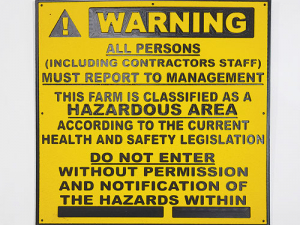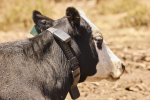It also brings the likelihood of more visitors to the farm – including advisors, friends or contractors. It is a sobering thought to learn that between 2000 and 2015, 89 contractors or working visitors lost their lives in agricultural accidents. In almost all these cases involved some form of vehicle or machine.
Therefore it’s a good time to think about a spring clean, not just for the farm, but also for health and safety guidelines. In particular, for visitors coming on to a property.
Landowners, farmers, advisors and contractors, will each have overlapping duties regarding health and safety. This means that they will all need to communicate ahead of any jobs, or every time a working visitor comes to the farm.
Farmers should ensure they know when advisors or contractors are on the farm – some will use a sign-in and sign-out system, others might prefer to meet personally or to have a quick phone or text. Prior to any work starting, the visiting worker must be made aware of potential danger areas or risks that they would not normally expect.
Examples would be unmarked holes or ditches in the area they will be working, unstable land or areas where spray with a withholding period has been used.
If a track is particularly tricky, the farmer might warn about things like blind brows or corners and note the need to keep speed down.
They also need to ensure that all farm buildings and work areas are safe, as well as ensuring that any activities that might put visitors at risk are either stopped, eliminated or minimised.
For their part, contractors should ensure that the farm owner or manager, workers and other visitors are familiar with the scope of the job they are undertaking – such as the area being worked and the need to keep well away from working or moving machinery.
Everyone on the farm, including visitors, should let each other know of any activities that they believe to be dangerous. This may mean a farmer setting speed limits for tractors and trailers during silage making, or the contractor excluding any visitors from a paddock being harvested.
The bottom line is that both farmer and contractor must evaluate, eliminate or minimise risks if they can do so. And if this is not possible, manage those risks to the extent that they can influence and control the problem.
It all starts with good communication. This can be by phone, or preferably by face to face contact, and – if necessary – with a walk around the area the visitor will be working in. This should help establish an understanding of problem areas, who is responsible during these operations and – ultimately – to prevent any gaps in managing health and safety.
If there are expected types of behaviour, or sets of farm rules, then the visitors should be made aware of these in advance.
Much can be achieved by planning, looking at each likely stage of the job being contemplated, agreeing who will take control to mitigate or eliminate the risk, and clearly understanding the implications on the businesses and staff.
This conversation can happen in the lead-up to the work, but it is always a good idea to have some sort of communication on the day the work starts to make sure situations haven’t changed and – if they have – an agreed a new plan of action.
On the day of the work, make sure everyone on farm knows who is doing what and where. Ensure everyone understands the farm emergency plan, that communication methods are available and that there are agreed emergency procedures if an accident should happen.
All this should ensure that owners, farmers, contractors and their staff are given the best opportunity to return to work over the coming days, weeks and months.









